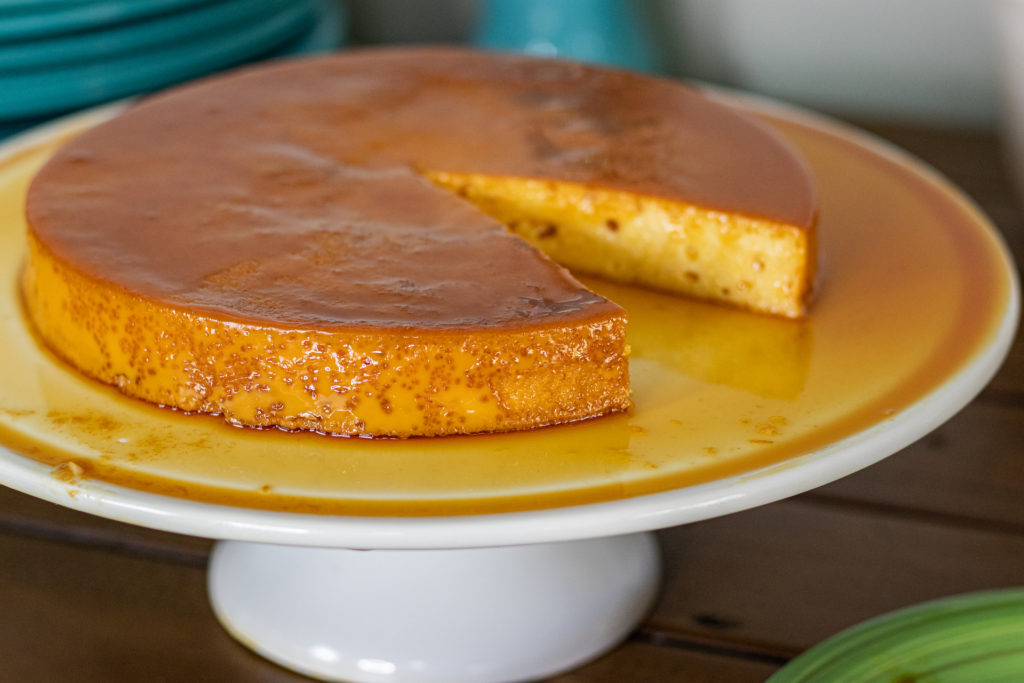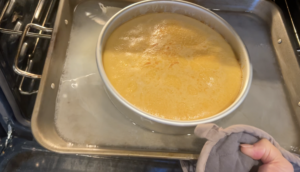Spanish Flan – Flan de Leche

I have been eating flan since I was a little girl and it has been my favorite dessert all of my life. It’s actually the only dessert I really like. I do not like sweets which is why you don’t see desserts on my blog. When I tell anyone, they cannot believe it. How can you be a food blogger and not like dessert? Well, that can totally happen and I am one of the examples.
This version is a Dominican one and the recipe I grew up really enjoying. Sweet but not overly sweet that you need to go see the dentist the next day. hahaha!
Facts about Flan
Flan’s history dates back to ancient Rome.The Romans were the first known civilization to domesticate chickens for farming purposes. With an abundance of eggs at their disposal, they began creating dishes that featured eggs as its main ingredient.
And that brought on the birth of flan. Originally, they used to serve it as a savory dish with meat or fish. Thankfully, cooks soon began experimenting with a sweet version that was flavored with honey and its popularity soared. It gets its name from the French word flaon, which comes from the Old German flado, a flat cake, because of its shape.
Eventually, it got to Spain and Spaniards brought the flan to Latin America in Spanish conquests and occupations.
Flan is a dessert. Smothered in melted caramel and very hard to resist. Give it a try and you will see!

And if you want to have some extra fun with flan, check out this amazing Flancocho I made in collaboration with Angela’s Dominican Cake Mix and Familia Kitchen!
Flancocho

Spanish Flan – Flan de Leche
Ingredients
- 1 cup granulated sugar
- 5 large eggs
- 1 12 oz sweetened condensed milk
- 1 12 oz can evaporated milk
- 1 tbsp vanilla extract
- 1 tbsp rum I used Brugal Añejo (Dominican Rum)
- 1/2 cup water, hot is best
Instructions
- Grease the bundt pan thoroughly.
- Start by caramelizing the sugar.Heat the sugar in a skillet over medium-high heat. Stir the sugar constantly. It will first start to clump and once it begins getting hot enough it will start to turn a golden brown and melt into a caramel. Continually stir until all the sugar has been liquefied and there are no more clumps left in the skillet. Do not leave the stove. Your caramel can go from perfect to burnt in the blink of an eye!
- Be very careful with this next step. You are going to pour the 1/2 cup of hot water over the melted sugar. It will probably splash, so you need to be careful and maintain your distance, as well as make sure to do this slowly. I used a lid to protect myself from splatter.Once you’ve poured the water over the caramel syrup, you will notice that the caramel will harden up. Bring mixture back to the heat, and keep stirring with your spatula until all the sugar has re-melted. Once the syrup is smooth and with a deep amber color, you can remove from the oven. It’s supposed to be a very thin and light syrup.
- Pour into bottom of bundt pan immediately. When pouring the caramel into the cake pan, make sure that it is spread evenly across the bottom of the entire pan. Very carefully rotate the pan so that the caramel will also partially cover the sides of the cake pan as well. The caramel is extremely hot and can cause severe burns if you get it on yourself, so make sure to always handle it very carefully. Keep rotating the caramel until it cools and hardens to the point that it no longer moves around. This can take 5 minutes or more so take a few 30 second breaks in between.
- Set the cake pan aside and allow the caramel to cool and harden.
- In a large bowl, add the eggs, sweetened condensed milk, evaporated milk, rum and vanilla extract and mix well until fully mixed.
- Set oven temperature to 350° degrees.
- Using a water bath, bake for 1 hour and 30 minutes.
- What is a water bath?A water bath is a pan of water placed in the oven. To use a water bath you simply fill a large enough pan with water, then place the baking dish, ramekins, etc. into the pan of water. … Water baths are used for recipes that require a moist environment and a less aggressive heat for cooking.
- When done, remove the flan from the water bath and set aside to cool down for a couple of hours. Then cover with foil and refrigerate overnight.
- When ready to unmold, remove the flan from the fridge. Using the same pan where you had your water bath in, pour hot water and place the bundt pan in the hot water. This will help the caramel loosen from the bottom by melting it slightly.
- Give the bundt pan a little jiggle, and if the flan jiggles around, you are good to go. Otherwise, place it back over the hot water. Flip the flan over its serving dish while giving it a little jiggle. And be prepared to be amazed!


